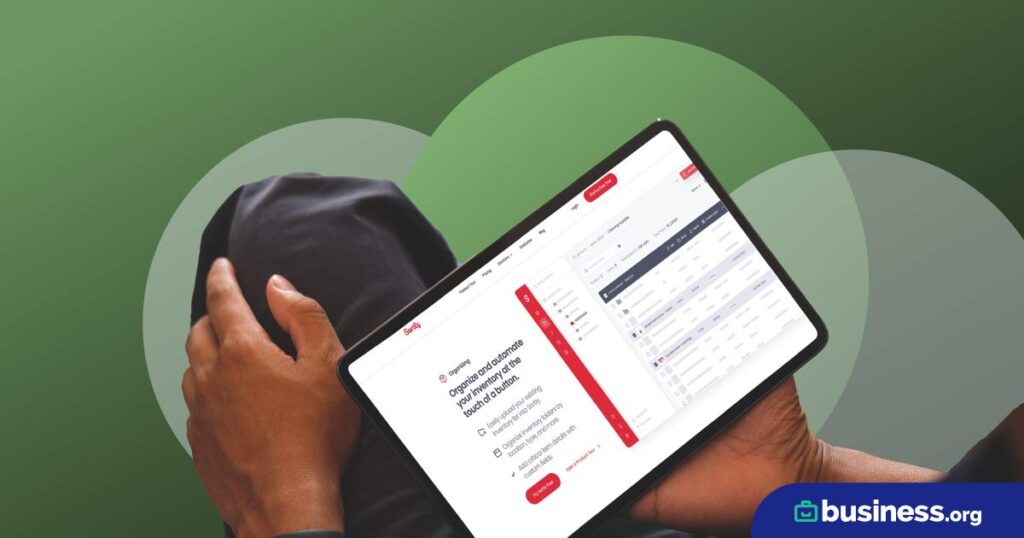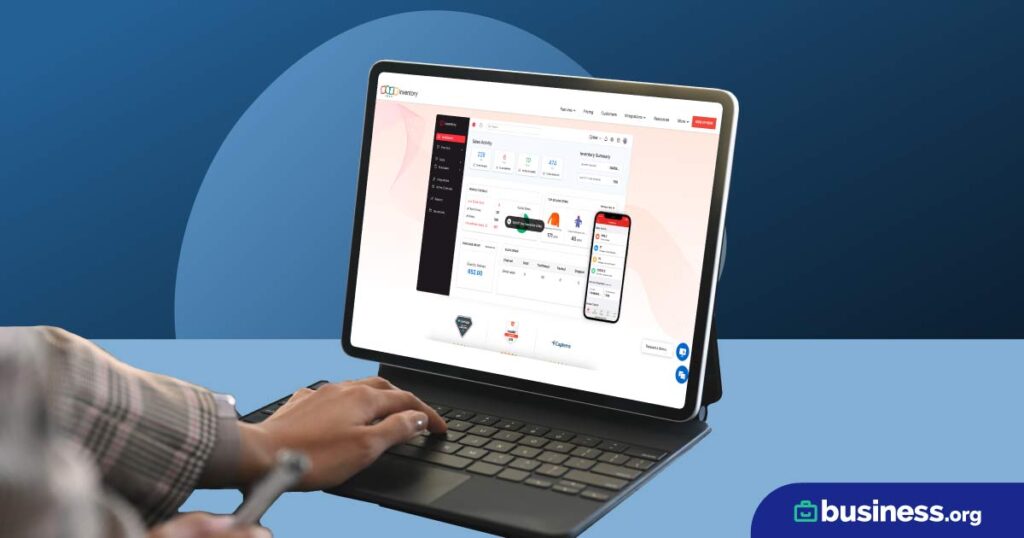We are committed to sharing unbiased reviews. Some of the links on our site are from our partners who compensate us. Read our editorial guidelines and advertising disclosure.
TradeGecko Review
Data as of 3/31/2020. Offers and availability may vary by location and are subject to change.
TradeGecko was acquired by QuickBooks in 2020. This review was written with the old TradeGecko platform in mind. If you are looking for a similar inventory management system, QuickBooks has developed QuickBooks Commerce. For regular inventory inventory management from QuickBooks, check out our review.
Until it was acquired by QuickBooks, TradeGecko enjoyed one of the best online reputations when it came to inventory management software. That’s hardly a surprise, considering TradeGecko users saw an average sales revenue increase of 50% after their first year of service.2
Since then, TradeGecko has been acquired by QuickBooks—and the TradeGecko inventory management system has been transformed into QuickBooks Commerce. But we had to wonder: Was TradeGecko all it was cracked up to be?
We did a deep dive into TradeGecko’s cloud-based platform to see what the service did well—and what it didn’t. Here’s what we came up with.
TradeGecko works best for wholesalers
Based on TradeGecko’s offerings, we thought it worked best for wholesale businesses. With a Small Business plan or higher, you could get a customizable B2B ecommerce site, which you could personalize with your brand colors, logo, and custom pricing for each client.
TradeGecko also offered a number of features and tools to simplify your invoicing and client payment process—which allowed you to get paid faster and spend less time processing sales orders. Plus, TradeGecko made order management smooth and easy.
That’s not to say, of course, that TradeGecko didn’t work for retail or ecommerce businesses. Far from it—the Founder plan was practically made for single-location retail stores. And the service offered integration with WooCommerce, Amazon, Shopify, and tons of other ecommerce platforms, so you could sell products online with ease.
TradeGecko pros and cons
TradeGecko pros
First and foremost, TradeGecko was one of the only inventory management platforms to offer a fully customizable B2B ecommerce website for its users. It also provided easy online payment options for wholesale clients—all of which provided your wholesale customers with a smooth, positive experience while ensuring you received on-time payments for outstanding invoices.
We also liked how easy TradeGecko was to use. Not only did the interface make it easy to find the features you needed but also the entire platform was designed to eliminate extra steps and streamline your inventory management. The service even included a number of features to help you easily sync your inventory with your accounting software.
Combine all that with the service’s top-notch onboarding service for new customers and the platform’s low rates, and it was clear that TradeGecko offered incredible value for the price.

Tradegecko cons
While TradeGecko offered a ton of useful tools, it was missing some key features. Once you entered a shipment or batch into your system as part of a pack, you couldn’t break down that pack into individual units. That was a big problem for businesses that sold full packs to wholesalers as well as individual items to retail customers. And unlike competitors like Cin7 and Fishbowl, TradeGecko didn’t offer a built-in point-of-sale solution.
While TradeGecko’s interface was clean and simple, we found that it had a tendency to get buggy after major updates—especially if those updates didn’t sync up with updates to your WooCommerce extensions or any other integrations used in your system. The service also lacked accessibility on the Android platform, as the TradeGecko app was available only on iOS devices.
TradeGecko’s customer service was also pretty spotty if you didn’t have a Business plan or higher. That wasn’t a total deal breaker (especially considering the service’s in-depth online knowledge base), but it sometimes made the platform frustrating to use for business owners who weren’t super tech-savvy.
TradeGecko plans and pricing
TradeGecko pricing ranged from $39 per month (a steal, in our opinion) to $799 per month. But these prices were based on an annual payment plan. If you decided to go month-to-month, you could still get the Founder plan for $39 per month, but the Lite, Small Business, and Business plans went up to $99 per month, $249 per month, and $699 per month, respectively.
Meanwhile, the Premium plan allowed only an annual subscription.
Data as of 3/31/2020. Offers and availability may vary by location and are subject to change.
*With annual payment
All of the plans above included a 14-day free trial period, so you were free to experiment with the platform to make sure it worked for your needs.
And on the off chance that you needed a plan that supported more sales orders, users, or sales channels than the Premium plan provided, you could get a custom quote for a Pro plan.
Key features of TradeGecko
Inventory management
TradeGecko had a lot of standard inventory management features—including the ability to list in-depth product information like weight, size, color, barcodes, costs, and expiration dates. You could also view each product’s restock history and consolidate all your business’s sales channels within a single platform (though the exact number of channels allowed depended on your plan).
However, TradeGecko also offered some inventory management features that weren’t so standard.
For instance, the TradeGecko platform supported bundling, kitting, and setting pack sizes. That helped you easily define groups of items that could be sold as one unit. TradeGecko also allowed you to use barcode scanners to search your product catalogue or add item info into your sales and purchase orders automatically.
With a Lite plan and above, TradeGecko also offered intense automation, thanks to the TradeGecko Connect feature. TradeGecko Connect could automatically calculate and set up reorder points, order quantities, lead demand metrics, recommended stock covers, and more for each item based on its sales and purchase history. That saved you time, since you didn’t have to manually calculate those metrics by hand.
Wholesale features
While TradeGecko did offer integration with Shopify and other online marketplaces (like the WooCommerce app), the platform really shone when it comes to its wholesale features.
TradeGecko users could set up a customizable B2B ecommerce website, which allowed your wholesale customers to shop your products (and see real-time stock numbers) on their own time. You could also choose featured products and deals to display.
To use this feature, business owners would set up profiles for their wholesale clients that specified the pricing and discounts displayed for each customer. Once those clients logged in, they could browse your current catalogue and place orders. Wholesale shoppers could even look up their past orders to reorder commonly purchased products.
Another wholesale feature we liked? TradeGecko’s seamless invoicing system. Once a wholesale client submitted an order, it converted to an invoice automatically. The system also inserted invoice payment due dates for you based on the payment terms you specified in advance.
Also included on the invoice was a nifty Pay Now button, which guided the customer through the TradeGecko Payments processor. This helped clients pay quickly and easily, plus it cut out the extra time spent on slow-going bank transfers and multiple payment platforms.
Keep in mind, though, that while TradeGecko Payments was included with any TradeGecko plan, it did come with transaction fees. These fees were fairly standard compared to other payment processors, though, so we didn’t think it would be a deal breaker for most businesses.
By signing up I agree to the Terms of Use and Privacy Policy.
Order management
TradeGecko made it easy to manage your sales and purchase orders.
For starters, you could set up custom workflows for different types of orders based on their order value, item quantity, sales channel, and more. At each step of each workflow, you could assign tags, standard shipping costs, invoice details, team member assignments, and trigger emails—that way you could automate things like order confirmation emails, employee reminder emails, and even Slack notifications within your organization.
TradeGecko also offered the ability to create sales orders on the go via the TradeGecko app. So if you were in a sales meeting or at a trade show, you could easily generate orders for new clients. The app then synced with your inventory management software, allowing your team to start work on packing and shipping immediately.
TradeGecko also simplified order fulfillment on backordered products. If you ever oversold a product, the platform would automatically consolidate all the outstanding sales orders for the unavailable item into a single purchase order for the supplier, making it easy to reorder the item and fulfill your customer orders as quickly as possible.
Warehouse management
If your business used multiple warehouses to fulfill orders, TradeGecko could help you simplify your inventory control. Like most other inventory systems that support multiple warehouses, TradeGecko allowed you to view stock levels and performance at each location. And you could easily transfer stock between warehouses if one location ran low.
In addition, TradeGecko allowed business owners to specify warehouse locations on their purchase orders and sales orders. This let suppliers deliver new stock directly to the locations that needed it most (rather than going through your central warehouse first) and sales orders could be fulfilled directly from the warehouse that made the most sense (based on location and stock availability).
Unlike other inventory management software, TradeGecko also let you transfer stock to consignment locations. And with a Business plan or higher, you could even track the bin numbers of each of your products within each warehouse. That way, you didn’t have to worry about misplacing inventory within your warehouse.
Reporting
TradeGecko’s reporting feature gave you a lot of insight into both your inventory and your sales.
Within your TradeGecko dashboard, you could quickly and easily access reporting for your on-hand stock, inventory by location, incoming stock, and historic inventory. These inventory control reports could be filtered by location, product type, and more. On the sales side, you could view historic and current sales order reports, filtered by product, variant, product type, sales channel, customer, sales rep, and location.
That gave you enhanced insight into the state of your business and the success or shortcomings of your current inventory control practices. And the fact that TradeGecko’s reports were so customizable gave the platform a leg up compared to many of its competitors.
Best of all, TradeGecko users with a Business plan or higher could access TradeGecko’s built-in demand forecasting. This feature helped you predict customer demand for each of your products in advance so you never had to worry about stockouts.
TradeGecko integrations
If you were using a third-party software for your accounting, ecommerce selling, shipping, or any other business need, there’s a good chance that TradeGecko offered an integration for it.
Here are just a few of the integrations you could use with your TradeGecko service:
- Accounting: Xero, QuickBooks Online
- Ecommerce: Amazon, Shopify, WooCommerce, Magento, BigCommerce, eBay
- Electronic data interchange (EDI): SPS Commerce, VL OMNI, B2BGateway, DSCO
- Forecasting: Inventory Planner, Lokad
- Point-of-sale: Shopify POS, Lightspeed
- Manufacturing: Katana
- Marketing: HubSpot, Klaviyo, MailChimp, Integromat
- Marketplaces: Amazon, Walmart, Etsy, Overstock, Wayfair, Joor, The Iconic
- Reporting: Inventory Planner, Lokad, 9Spokes
- Shipping: Fulfillment by Amazon, ShipStation, Shiptheory, Shippit, Easyship, ShipBob
- Third-party logistics (3PL): Fulfillment by Amazon, 3PL Central, Fulfyld, VeraCore
- WMS: CIO Direct, ShipHero, Sphere WMS, Rakuten Super Logistics
- Other: Zapier, Slack, Google Drive, DataBot, CommerceHub, Inventory Source
One thing to bear in mind, though: while some of these integrations were developed (and supported) by TradeGecko directly, many integrations were created by third-party developers—so results weren’t guaranteed.
Customer support
TradeGecko support was kind of a mixed bag, if we’re being honest.
On the one hand, the service’s online knowledge base was outstanding. It featured e-books, webinars, and handy tutorials that guided you through pretty much every task step by step. So whether you were trying to add a new product or figure out how to reconcile inventory counts, you could find a walkthrough to help.
TradeGecko also offered great onboarding support. In fact, if you signed up for a Small Business plan or higher, you could get two to eight hours of personal setup assistance from a member of the TradeGecko team.
What’s more, TradeGecko offered 24/7 customer service to all customers. But here’s the catch: it was 24/7 email support—meaning you could send an email anytime, but you’d have to wait for the TradeGecko team’s normal office hours to get a response. Since TradeGecko’s headquarters were in Singapore, that meant North American users often wouldn’t get a response to their concerns until the following business day.
Of course, you could get 24/7 phone support and a dedicated account manager—but only if you paid the extra cash for a Premium plan.
The takeaway
TradeGecko offered wholesale features that made the service difficult to ignore for anyone running a B2B business. The platform was clean and easy to use, so you could streamline your business processes and get stuff done in just a click or two. And with plans starting at only $39 per month, TradeGecko was a great value—even if its updates occasionally caused some bugs and its app wasn’t available on Android devices.
Since TradeGecko is no longer available, check out QuickBooks Commerce that has taken over many of the TradeGecko features since the brand was acquired by QuickBooks.
Related content
TradeGecko FAQs
What is TradeGecko?
TradeGecko was a cloud-based inventory management solution operated by TradeGecko PTE Ltd. The service allowed you to track your inventory in real time, process invoices, fulfill customer orders from multiple sales channels, and more—all within a single platform. In 2020, TradeGecko was acquired by QuickBooks and subsequently shut down in order to become QuickBooks Commerce.
What's the difference between wholesale and retail?
The main difference between wholesale and retail is who you’re selling to. Retailers sell their products directly to their consumers. Meanwhile, wholesalers sell products to other businesses (usually in bulk) that then sell those products to consumers at an inflated cost.
Is TradeGecko the best inventory management software?
Considering that TradeGecko is no longer in operation, we probably wouldn’t recommend it as a viable option for managing your inventory. Instead, we recommend checking out our list of the best inventory management software to see our other top picks.
Should I get inventory management software at all?
We’re big believers in getting inventory management software if you can. But not every business can—and that’s okay. Tracking your inventory with programs like Excel can be simpler and more cost-efficient.
If you’re leaning toward the DIY route, though, you may want to consider using one of the many free Excel spreadsheet templates available online.
We at Business.org think we can do better than a run-of-the-mill spreadsheet. With our inventory management template for Microsoft Excel, you can easily track stock levels, view items that need to be reordered, and identify late sales and purchase orders. Easy peasy.
Sources
- TradeGecko, "Inventory Management Software". Accessed March 31, 2020.
- TradeGecko, "Inventory Management Software". Accessed March 31, 2020.
- Capterra, "TradeGecko Reviews and Pricing". Accessed March 31, 2020.
Disclaimer
At Business.org, our research is meant to offer general product and service recommendations. We don't guarantee that our suggestions will work best for each individual or business, so consider your unique needs when choosing products and services.








